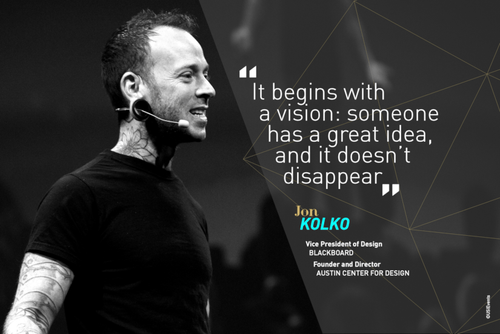Jon Kolko - What are the keys steps of product management ?
By placing the user at the heart of the product, the digital revolution makes us rethink product development methods.
Jon Kolko, speaker at USI 2016, define the key step of product management thanks to the experience of the myEdu project.
The question of product management is raised because product development methods have evolved largely in the past few years. The main question is therefore to ask what the real source of a good product is: is it the result of a vision, a process or hard work? Jon Kolko believes in a three-step approach:
- The definition of a vision on the part of a company manager or employee;
- The creation of a consensus around that vision to mobilize all skills around one conviction;
- The development of a product on the basis of that conviction.

For product management, three skills are needed:
- Understanding a market and how to integrate a product into it: what existing infrastructures or legislations make the product a success, what are the social precedents in terms of failure or success, etc.;
- Learning user behaviors to find solutions: what value proposition can gather a large number of users, is the product in line with the identity of its users;
- Delivering a product in a pragmatic manner: how to adopt a design thinking approach, how to develop the best functionalities, how to make the different roles of marketing, engineering and design work together.
Read : Our interview with Jon Kolko "Design should be a liberal art"



The my Edu project
The idea of myEdu stems from the observation of two issues in the American university system.
From the students’ point of view, the soaring costs of higher education forces them to borrow around 36,000 dollars on average when only 59% of students get their diploma. From the employers’ point of view, platforms such as LinkedIn do not help recruit students on the basis of skills actually acquired.
myEdu aims to solve both problems by creating a platform that is more adapted to students and recruiters and that is more integrated than LinkedIn. Recruiters and students are linked via the platform and students can create an “aspirational profile” which sums up their credentials in terms of acquired skills and accomplishments (volunteer work, projects…) rather than through a diploma alone.
Today, the platform has 2 million members and the success is largely due to the product management method followed, as it helped the team understand how the product could be esthetic and didactic for the user.
The key steps of product management
The feedback of myEdu helps define several steps towards a product management method that can be used for any project:
- Contextual research: spend time with users (i.e.: students and recruiters) to understand their needs and determine business opportunities.
- Synthesis & sense matching: transcribe and sort collected data to identify anomalies and design development models (e.g.: the lack of a transparent marketplace for student jobs).
- Behavioral insights: this is the most important step as it gives a direction to the product and it helps understand how the user acts and how the user thinks that other users act by determining insights or “moments of truth”.
- Value proposition: offer a solution to reduce the gap between offer and demand thus creating a commercial opportunity.
- Feature definition: pragmatically develop functionalities that support this commercial solution (e.g.: visualizing skills).
- Launch and measure: launch the product and create automated reporting processes to follow user behaviors (e.g.: what skills were provided/ reviewed) and integrate new needs to production.
- Communication & strategy: put forward the value of the product (i.e.: functionalities) and convey them to users_._
- Community feedback: observe users during a real session and analyze customer service information to understand how the product works and solve problems encountered.
To go further, discover Jon Kolko’s talk on our Youtube channel
